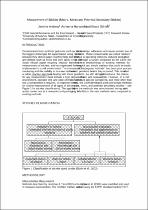JavaScript is disabled for your browser. Some features of this site may not work without it.
- ResearchSpace
- →
- Research Publications/Outputs
- →
- Journal Articles
- →
- View Item
| dc.contributor.author |
Andrew, J

|
|
| dc.contributor.author |
Hanuman, A

|
|
| dc.contributor.author |
Sithole, Bishop B

|
|
| dc.date.accessioned | 2011-07-13T14:25:20Z | |
| dc.date.available | 2011-07-13T14:25:20Z | |
| dc.date.issued | 2011-01 | |
| dc.identifier.citation | Andrew, J, Hanuman, A, and Sithole, B.B. 2011. Measurement of stickies (Macro, Micro and Potential Secondary Stickies). Journal for the Technical Association of the Pulp and Paper Industry of South Africa (TAPPSA), Vol. 1, pp. 10-12. | en_US |
| dc.identifier.uri | http://www.tappsa.co.za/tappsa_journal.html | |
| dc.identifier.uri | http://hdl.handle.net/10204/5102 | |
| dc.description | Copyright: 2011 TAPPSA. This is a pre print version of the work. The definitive version is published in the Journal for the Technical Association of the Pulp and Paper Industry of South Africa (TAPPSA), Vol. 1, pp. 10-12 | en_US |
| dc.description.abstract | Contaminants from synthetic polymers such as plastics, coatings, adhesives and waxes remain one of the biggest challenges for papermakers using recovered fibre. These contaminants are called “stickies” because they stick to paper machine felts and wires leading to operating problems, reduced productivity and defects such as holes and dark spots in the paper. Through a survey conducted by the CSIR, the South African paper recycling industry identified several shortcomings of existing methods for measurement of stickies, and has expressed the need for quick and simple methods that could be easily implemented in a mill environment. The consequence of "inadequate methods" has been poor process monitoring and the inability to fore-see stickies-related problems before they occurred. This resulted in a rather reactive approach to dealing with these problems. As with all testing procedures, the criteria for any measurement must include a high degree of precision and repeatability. However, in a mill environment, operator time and ease of implementation must also be considered, and more often than not, a compromise is required. In response to this need, the CSIR developed quick and simple methods for routine measurement of all types of stickies (macro, micro, and potential secondary stickies. The applicability of the methods was demonstrated during stickies audits carried out at a newsprint and packaging mill. | en_US |
| dc.language.iso | en | en_US |
| dc.relation.ispartofseries | Workflow;6525 | |
| dc.subject | Synthetic polymers | en_US |
| dc.subject | Synthetic polymer contamination | en_US |
| dc.subject | Paper recycling | en_US |
| dc.subject | Packaging mill | en_US |
| dc.subject | Potential Secondary Stickies | en_US |
| dc.title | Measurement of stickies (Macro, Micro and Potential Secondary Stickies) | en_US |
| dc.type | Article | en_US |
| dc.identifier.apacitation | Andrew, J., Hanuman, A., & Sithole, B. B. (2011). Measurement of stickies (Macro, Micro and Potential Secondary Stickies). http://hdl.handle.net/10204/5102 | en_ZA |
| dc.identifier.chicagocitation | Andrew, J, A Hanuman, and Bishop B Sithole "Measurement of stickies (Macro, Micro and Potential Secondary Stickies)." (2011) http://hdl.handle.net/10204/5102 | en_ZA |
| dc.identifier.vancouvercitation | Andrew J, Hanuman A, Sithole BB. Measurement of stickies (Macro, Micro and Potential Secondary Stickies). 2011; http://hdl.handle.net/10204/5102. | en_ZA |
| dc.identifier.ris | TY - Article AU - Andrew, J AU - Hanuman, A AU - Sithole, Bishop B AB - Contaminants from synthetic polymers such as plastics, coatings, adhesives and waxes remain one of the biggest challenges for papermakers using recovered fibre. These contaminants are called “stickies” because they stick to paper machine felts and wires leading to operating problems, reduced productivity and defects such as holes and dark spots in the paper. Through a survey conducted by the CSIR, the South African paper recycling industry identified several shortcomings of existing methods for measurement of stickies, and has expressed the need for quick and simple methods that could be easily implemented in a mill environment. The consequence of "inadequate methods" has been poor process monitoring and the inability to fore-see stickies-related problems before they occurred. This resulted in a rather reactive approach to dealing with these problems. As with all testing procedures, the criteria for any measurement must include a high degree of precision and repeatability. However, in a mill environment, operator time and ease of implementation must also be considered, and more often than not, a compromise is required. In response to this need, the CSIR developed quick and simple methods for routine measurement of all types of stickies (macro, micro, and potential secondary stickies. The applicability of the methods was demonstrated during stickies audits carried out at a newsprint and packaging mill. DA - 2011-01 DB - ResearchSpace DP - CSIR KW - Synthetic polymers KW - Synthetic polymer contamination KW - Paper recycling KW - Packaging mill KW - Potential Secondary Stickies LK - https://researchspace.csir.co.za PY - 2011 T1 - Measurement of stickies (Macro, Micro and Potential Secondary Stickies) TI - Measurement of stickies (Macro, Micro and Potential Secondary Stickies) UR - http://hdl.handle.net/10204/5102 ER - | en_ZA |






